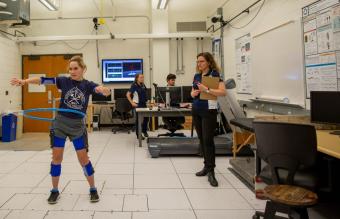Mines researcher playing key role in $15M NSF Integrative Movement Sciences Institute
Biomechanics expert Anne Silverman will lead institute’s resilience and versatility research

A Colorado School of Mines researcher is on the leadership team of a new $15 million National Science Foundation institute dedicated to improving our understanding of muscle mechanics and control.
Anne Silverman, associate professor of mechanical engineering at Mines, is one of five co-principal investigators for the new Integrative Movement Sciences Institute, announced earlier this week as part of NSF’s Biology Integration Institutes program.
Led by Monica Daley at the University of California, Irvine, the Integrative Movement Sciences Institute will bring together experts from 21 institutions across the U.S. for interdisciplinary research and training. By integrating investigations across different scales and timescales, from molecules to organisms and nanoseconds to generations, the institute aims to drive innovation in biophysics, physiology, biomechanics, neuroscience and engineering.
“This institute is going to transform the field of movement biomechanics,” Silverman said. “The results of this work have clinical implications for understanding aging and movement disorders, and applications for assistive technology development.”
Over the next six years, the core research of the institute will focus on intrinsic muscle dynamics, neuromechanical control, resilience and versatility, risk-reward and learning, and diversity and convergence in motor systems. These cores will critically examine assumptions of current approaches, develop new experiments and models and construct a dynamic muscle movement paradigm to transform basic science, clinical applications, and technological advancements.
At Mines, Silverman will lead the resilience and versatility work, conducting multiple biomechanical studies focused on the organism level and evaluating movement coordination.
“Individual organisms/people are inherently variable – we have different sizes, muscle strength, flexibility, muscle material properties, bone shapes. While variability is often something to control for in a scientific context, the institute is going to explore this variability to understand how organisms are resilient to varying environments and adapt to individual capability,” Silverman said. “We all move in different ways given our past experiences and physical capability – we want to figure out why.”
To do that, her team will conduct both experimental work and musculoskeletal modeling and simulation at the organism level. Researchers will also integrate what is learned from other scales – biophysical models of muscle, tissue level dynamics and more – into whole body movements and simulations, to better link these scales of our underlying biology and our output movement behavior.
The institute will foster a collaborative community and provide over 450 trainees with interdisciplinary scientific training, inclusive mentoring, and a wide professional network over the next six years. The institute will create a training pipeline from undergraduates to faculty, transforming movement sciences by integrating disciplines, organisms and structural scales.
Fellow co-PIs are Jill McNitt-Gray from USC, Kiisa Nishikawa from Northern Arizona University, and Simon Sponberg from the Georgia Institute of Technology.
“Often our experiments and models are isolated in specific subfields or focus on a particular size scale,” Silverman said. “With IMSI, we are discovering how muscles work on short timescales (less than a second) to generations (multiple lifetimes), and from molecules all the way up to ecosystems.”




